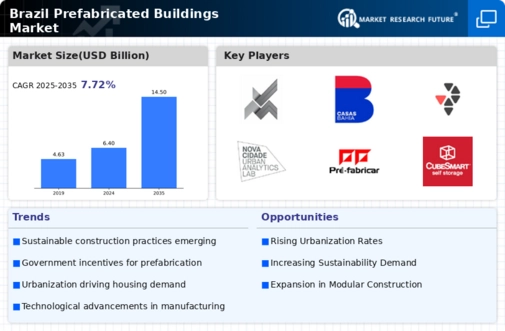Rising Urban Population
Brazil's urban population is on the rise, creating an urgent demand for housing solutions. The prefabricated buildings market is well-positioned to address this challenge, as these structures can be rapidly deployed to meet the needs of urban centers. Current estimates suggest that over 85% of Brazil's population will reside in urban areas by 2030, intensifying the pressure on housing supply. Prefabricated buildings offer a viable solution, as they can be constructed quickly and efficiently, making them ideal for urban environments where space is limited. This demographic trend is likely to drive the adoption of prefabricated buildings, as cities seek innovative ways to accommodate their expanding populations.
Cost Efficiency in Construction
The prefabricated buildings market in Brazil is shifting towards cost efficiency in construction. By utilizing prefabricated components, builders can significantly reduce labor costs and construction time. Reports indicate that projects utilizing prefabricated methods can save up to 30% in overall costs compared to traditional construction methods. This financial advantage is particularly appealing in a country where construction budgets are often constrained. Additionally, the reduced waste generated during the prefabrication process contributes to lower disposal costs, further enhancing the economic viability of these structures. As a result, the demand for prefabricated buildings is likely to increase, driven by the need for cost-effective solutions in the Brazilian construction sector.
Regulatory Support and Incentives
In Brazil, government policies and regulations are increasingly favoring the prefabricated buildings market. Authorities are recognizing the benefits of prefabricated construction in terms of efficiency and sustainability. Various incentives, such as tax breaks and streamlined permitting processes, are being introduced to encourage the adoption of prefabricated methods. For instance, the Brazilian government has implemented programs aimed at promoting affordable housing solutions, which often include prefabricated options. This regulatory support not only facilitates market entry for new players but also encourages existing companies to innovate and expand their offerings. Consequently, the prefabricated buildings market is poised for growth as these supportive measures take effect.
Technological Integration in Construction
Advanced technologies are transforming the construction landscape in Brazil's prefabricated buildings market. Innovations such as Building Information Modeling (BIM) and automated manufacturing processes are enhancing the precision and quality of prefabricated components. These technologies enable manufacturers to produce buildings that are not only faster to assemble but also more durable and energy-efficient. As Brazilian construction firms increasingly adopt these technologies, the prefabricated buildings market is expected to benefit from improved product offerings and reduced construction timelines. This technological evolution may also attract investment, further bolstering the market's growth potential.
Sustainability and Environmental Considerations
Sustainability is becoming a critical driver in the prefabricated buildings market in Brazil. With growing awareness of environmental issues, there is an increasing demand for construction methods that minimize ecological impact. Prefabricated buildings are often designed with sustainable materials and energy-efficient systems, appealing to environmentally conscious consumers and businesses. Furthermore, the reduced waste generated during the prefabrication process aligns with Brazil's commitment to sustainable development. As more stakeholders prioritize eco-friendly practices, the prefabricated buildings market is likely to see a surge in demand, reflecting a broader trend towards sustainability in the construction industry.


















Leave a Comment